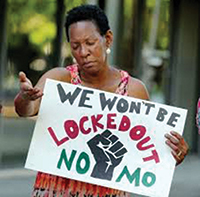 Returning prisoners face numerous challenges when returning to their communities, and access to housing is one of the largest obstacles. Subsidized housing programs can often have very restrictive criteria for renting to applicants with any conviction history. Very often, stable housing is a key factor in keeping returning prisoners from activities that may send them straight back to jail. Several communities throughout the country are taking action to create new programs and policies to open doors to this often overlooked group in need of housing support.
Returning prisoners face numerous challenges when returning to their communities, and access to housing is one of the largest obstacles. Subsidized housing programs can often have very restrictive criteria for renting to applicants with any conviction history. Very often, stable housing is a key factor in keeping returning prisoners from activities that may send them straight back to jail. Several communities throughout the country are taking action to create new programs and policies to open doors to this often overlooked group in need of housing support.
Here are just a few examples….
Gwinnett GA Program Provides Housing and Services to Those Leaving Correctional Facilities
The Gwinnett Reentry Intervention Program (GRIP) is an innovative program in Gwinnett County, GA that provides housing and supportive services to individuals leaving correctional institutions. The program seeks to assist ex-offenders in making their transition back into society a success.
GRIP provides returning citizens with transitional housing, job training, health screening, and help applying for social security disability (SSDI) and supplemental security income (SSI) programs. GRIP also connects returning citizens to mental health treatment—a vital resource as 60% of inmates in Gwinnett County report symptoms of mental illness.
When a returning citizen is ready to transition to permanent housing, GRIP assists with that process, locating landlords willing to house individuals with criminal records. This assistance is vital, as the inability to find affordable housing is one of the chief barriers that prevents many returning citizens from successfully reengaging in their community.
By providing stable housing and case management services, GRIP has helped thousands of individuals successfully transition back into society. Before the program began, 25% of individuals who left Gwinnett County Jail returned to jail within three years of their release. But only 8% of GRIP participants returned to jail in the three years following their release. By reducing recidivism, GRIP saves the county money, lowers the barriers to housing for ex-offenders, and helps the community at large benefit from safer neighborhoods.

New Orleans resident Marlene Kennedy prays during a 24-hour vigil hosted by VOTE, Stand with Dignity, and other advocacy groups. The vigil outside the city’s housing authority was designed to draw attention to bans on people with criminal records living in public housing. Ms. Kennedy was an inmate in St. Gabriel Prison. Image by Eliot Kamenitz of the New Orleans Advocate.
New Orleans Housing Authority Revises Policy for Screening Those with Criminal Records
Former HUD Secretary Julián Castro announced in April, 2016 that housing authorities could no longer use arrest records to discriminate against individuals applying for housing assistance. This decision reversed decades of HUD policy that had favored one-strike evictions for residents of public housing and recipients of Housing Choice Vouchers. As housing authorities have begun to review and redesign their screening procedures in light of the decision, the Housing Authority of New Orleans (HANO) has become an example of how a more comprehensive approach to applicant screening can be successfully implemented for the benefit of individuals and the community.
In May of 2016, HANO finalized a new occupancy plan changing the screening process for new applicants. Previously, HANO had refused to accept any applicants with criminal records and did not allow individuals with criminal records to be added to existing leases. As a result, residents leaving the criminal justice system had very limited options for safe and stable housing. They were unable to legally reside with family members or friends who lived in public housing, and they could not receive assistance on their own. Many returning citizens lived with relatives or friends in public housing without being added to the lease, which put the lease holder at risk of eviction and left HANO with inaccurate records about their residents.
New Orleans community groups including Stand with Dignity!, Voice for the Ex-Offender, and Vera Institute of Justice began in 2012 to advocate for changes to the HANO policies that banned individuals with criminal records from living in public housing. They argued that the policies denied returning citizens second chances, furthered racial discrimination, and made communities less stable. In 2013, HANO announced it would begin developing new screening policies that would soften many of the restrictions on returning citizens.
After three years of developing the new policies, in cooperation with advocates, residents and local officials, HANO received approval of their new screening system from HUD. The plan first looks at a person’s conviction; HUD regulations prohibit housing authorities from housing individuals who have been convicted of making methamphetamine on public housing property and those who are on the lifetime sex offender registry. These are the only applicants HANO prohibits without further consideration. All other applicants enter HANO’s Screening Criteria Grid, which considers the type of conviction and the length of time since the conviction. Most applicants pass through the Grid without issue and are admitted to a HANO property or the public housing waiting list. HANO refers some applicants who have more serious convictions to a panel for further review. The panel is made up of two senior HANO representatives and a resident representative. Together, they consider an individual’s circumstances and hear testimony from parole officers, employers, friends, and family. The panel then votes on whether the individual should be admitted.
Advocates in New Orleans and around the country are celebrating the new screening process and offer it as a model for public housing authorities around the country as they work to incorporate HUD’s new guidance on screening applicants and their criminal records into their policies.

“I Just Want to Come Home” © Groundswell 2015
NYCHA Completes Family Reentry Pilot Program
The New York City Housing Authority (NYCHA) recently completed a two-year Family Reentry Pilot Program (FRPP) to ease restrictions on former prison inmates in public housing. NYCHA launched FRPP in collaboration with the Corporation for Supportive Housing, the NYC Department of Homeless Services, the NYS Department of Corrections and Community Supervision, and the Vera Institute of Justice, along with over a dozen direct reentry service providers across the city.
From 2013-2015, FRPP screened former inmates released within the previous three years and provided them with supportive reentry services, with the goal of adding them to their family’s lease upon completion of the program. Applicants needed to be at least 16 years old, interested in reuniting with family currently living in a NYCHA apartment, and willing to participate in supportive reentry services for six months to two years.
The Vera Institute evaluated the program and conducted interviews with program participants, which they published in a November 2016 report, Coming Home: An Evaluation of the New York City Housing Authority’s Family Reentry Pilot Program. Vera identified 1,953 recently released former inmates as being eligible to participate in the pilot. Of those, 153 applied for the program and 85 were accepted. Coming Home reports overwhelmingly successful results of the pilot, and the organizations that collaborated to launch FRPP enthusiastically advocate for its continuation and expansion.
Of the 85 people accepted into the program, none has committed a new crime or violated parole since reentry, showing the program eliminated the recidivism common among former inmates. Roughly half of FRPP participants interviewed by Vera researchers indicated they would be homeless or living in a shelter or other transitional housing facility if they were not accepted into the program. Nationally, four out of every ten former inmates return to prison within three years of release, and homelessness is often a contributing factor in that cycle. The study also revealed that participants and their families experienced mutual benefits from their reunion, especially in cases where the program participant reunited with an elderly family member. Often, the program participant became a primary caregiver for that elderly relative. The program has allowed participants the access to housing stability they need to successfully rebuild family and social connections, find and maintain employment, continue their education, and reintegrate into their home communities.
NYCHA, home to more than 400,000 New Yorkers, was one of the first public housing authorities (PHAs) in the nation to pilot such a program after HUD urged PHAs in 2011 to examine their restrictions on former prison inmates in housing admission policies to combat homelessness among former inmates, reduce recidivism, and reunite former inmates with their families. Then-HUD Secretary Shaun Donovan said at the time, “People who have paid their debt to society deserve the opportunity to become productive citizens and caring parents, to set the past aside and embrace the future…part of that support means helping ex-offenders gain access to one of the most fundamental building blocks of a stable life—a place to live.” It remains to be seen whether New York City will introduce an expanded and more permanent reentry program, but Vera estimates that as many as 500 people per year returning home to the city would qualify for FRPP in its most recent form.
To read the full Coming Home report, visit: http://bit.ly/2fCvN7k
For information on NLIHC’s criminal justice reform efforts, visit: http://nlihc.org/issues/criminal-justice.
